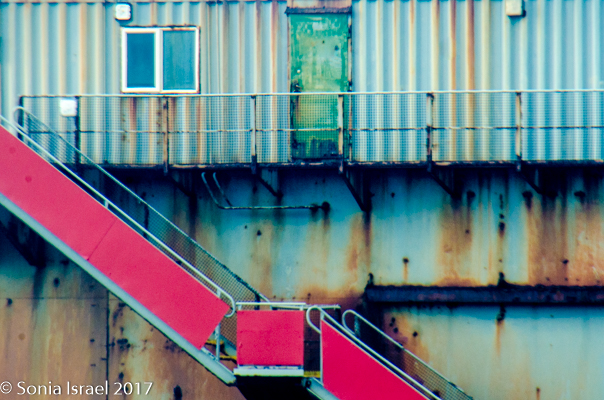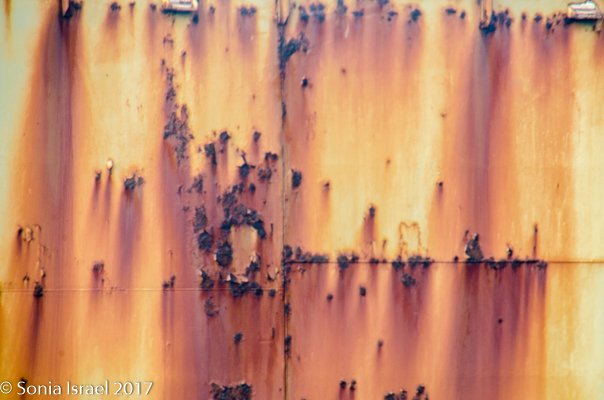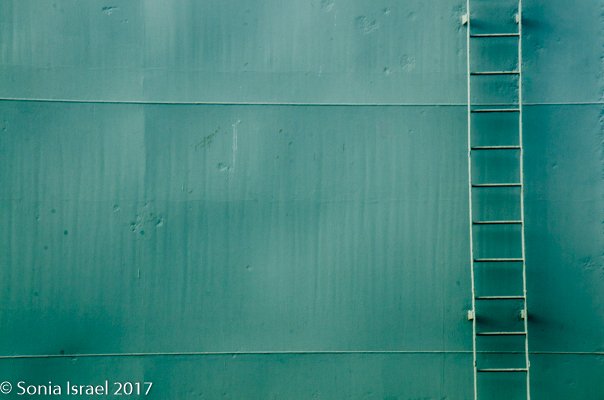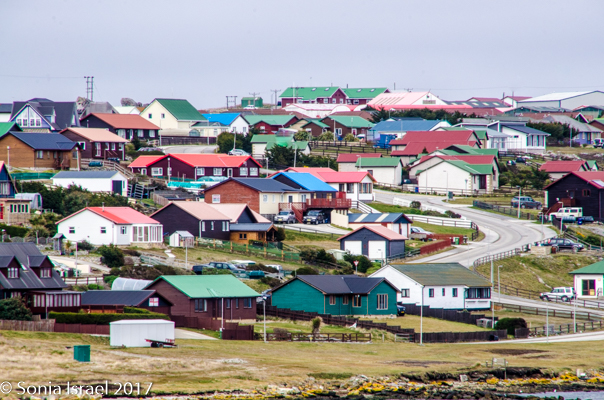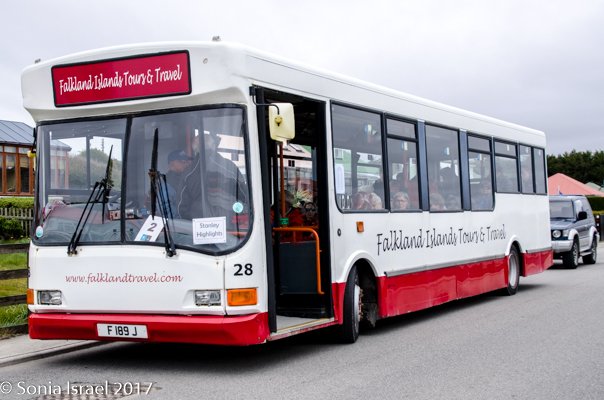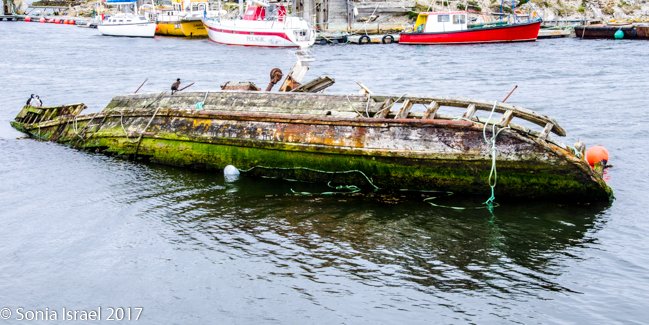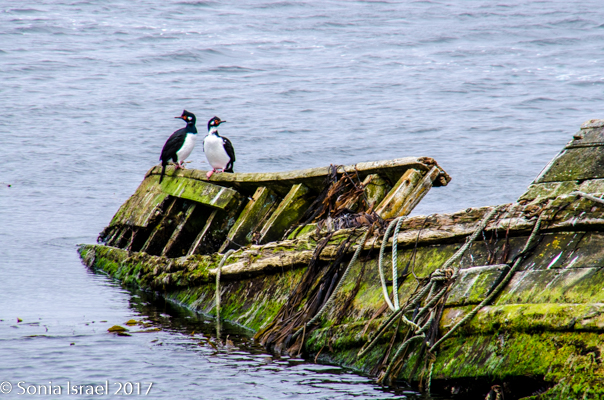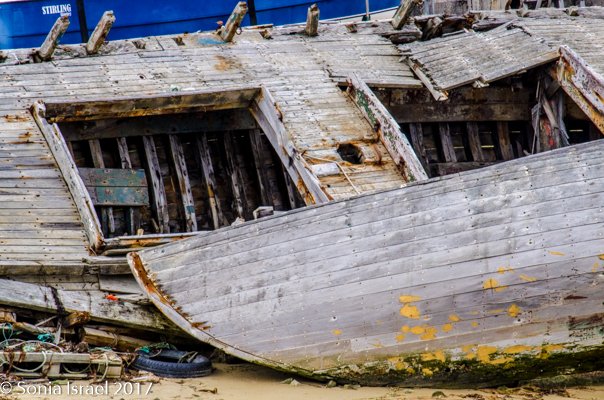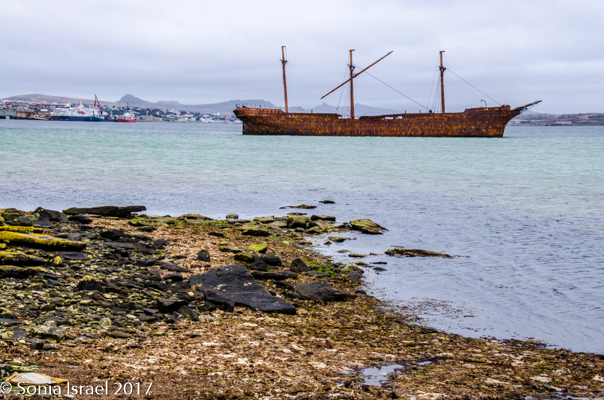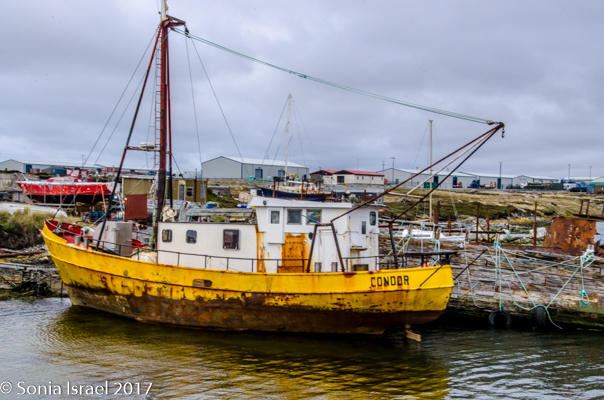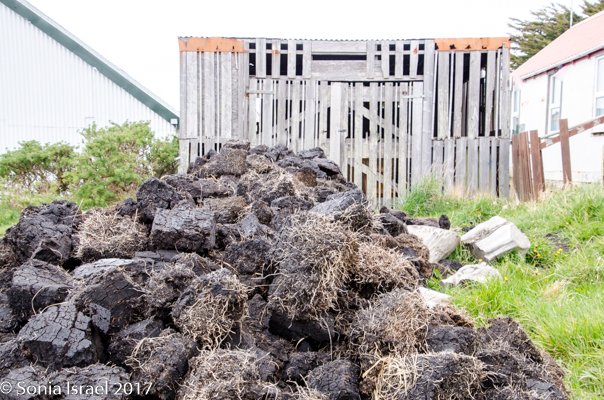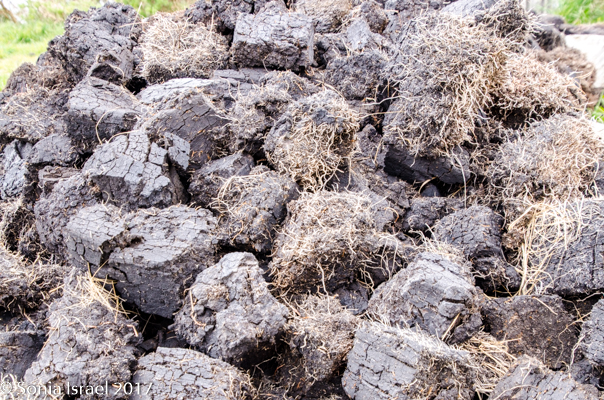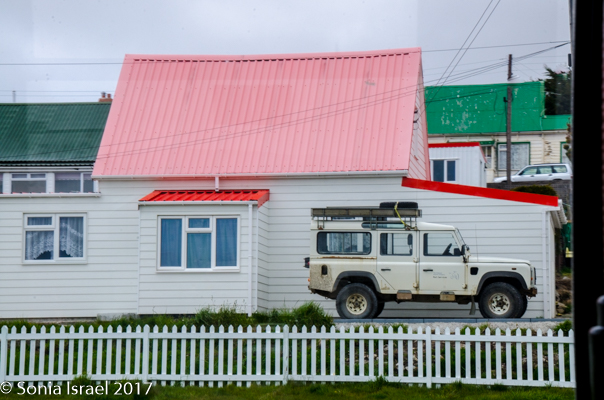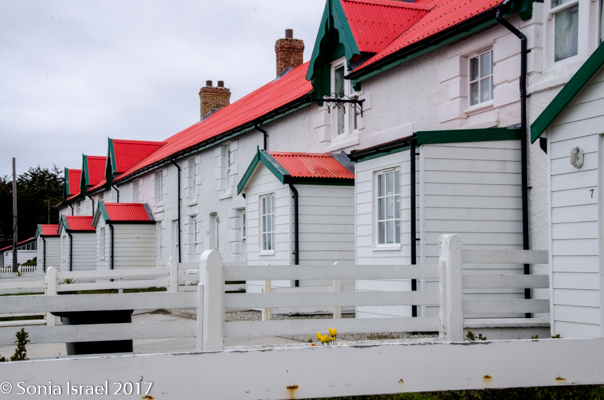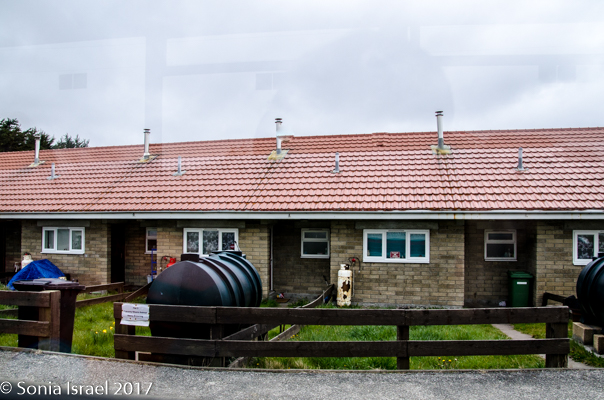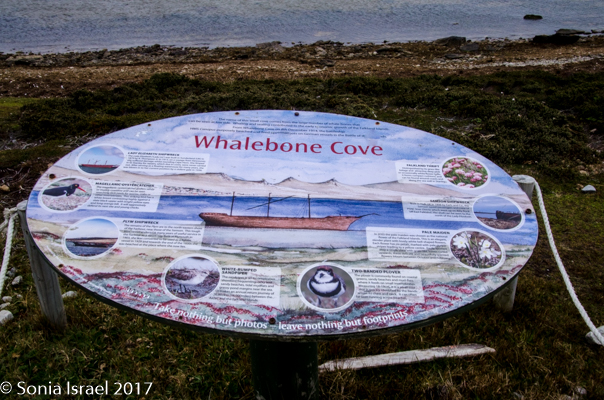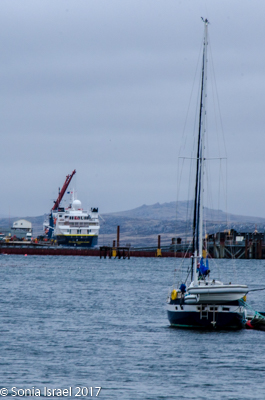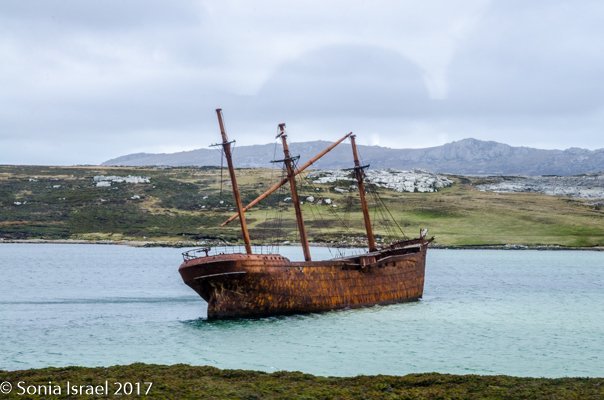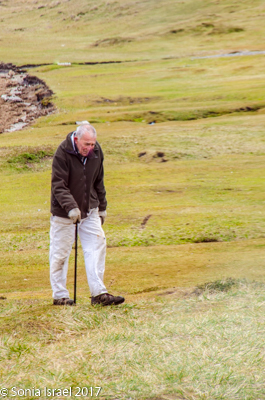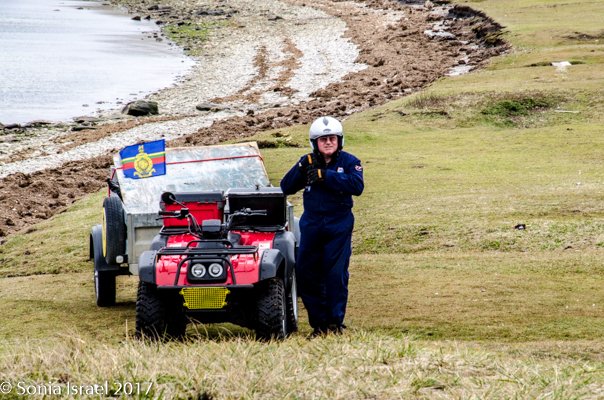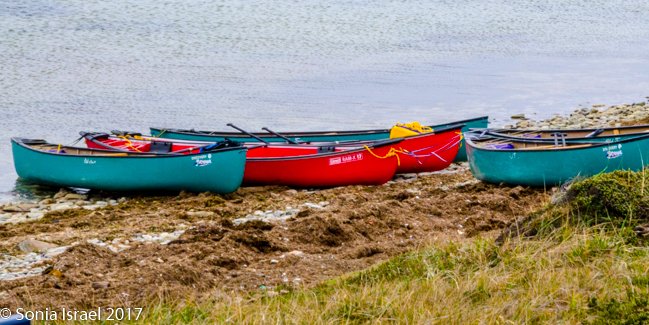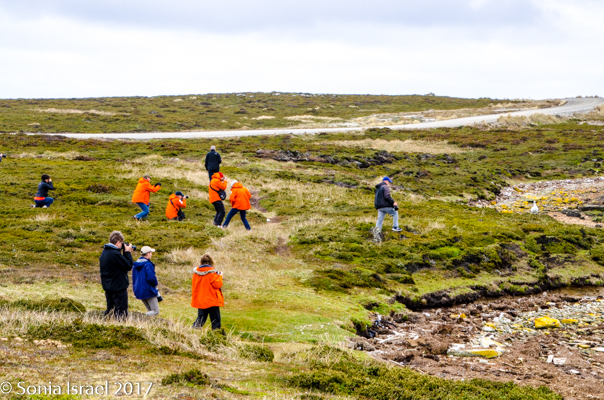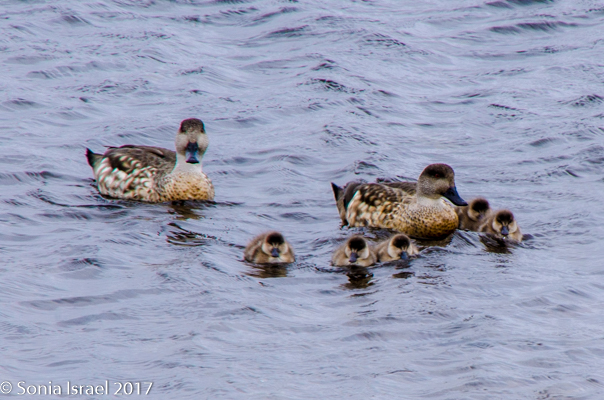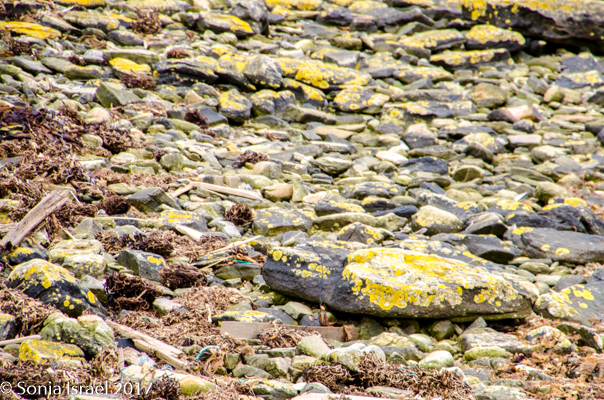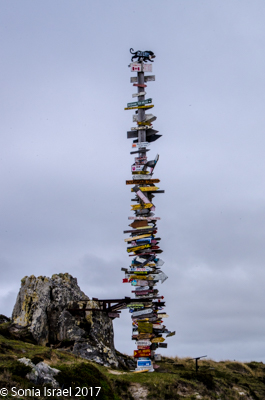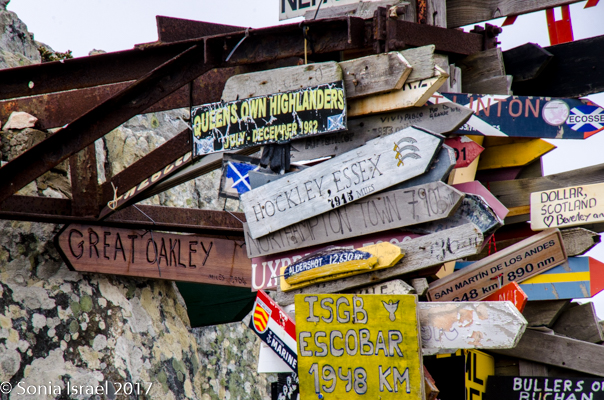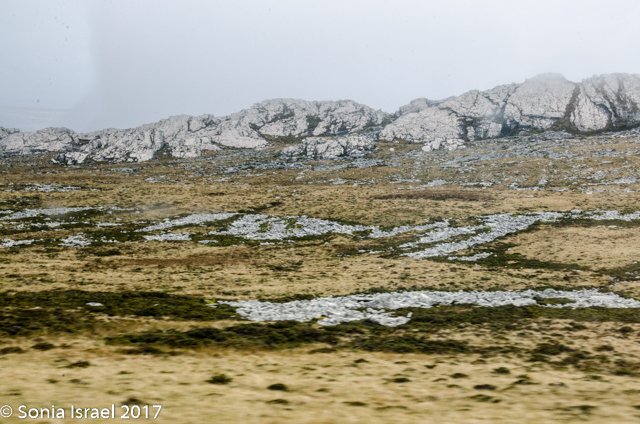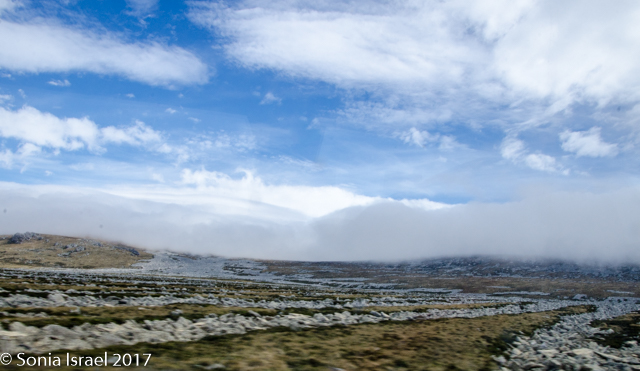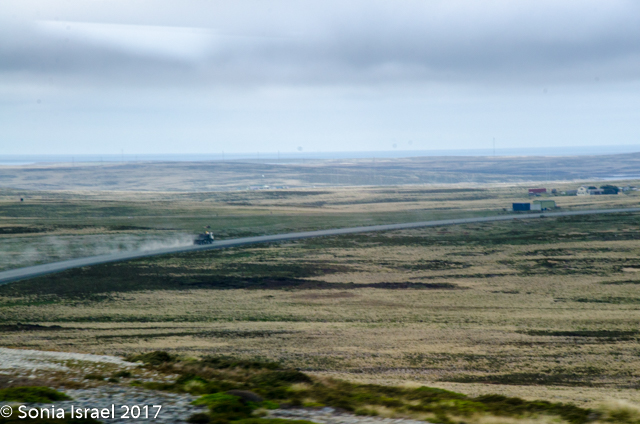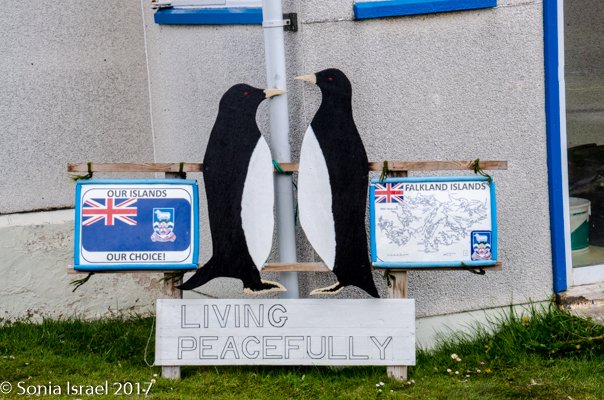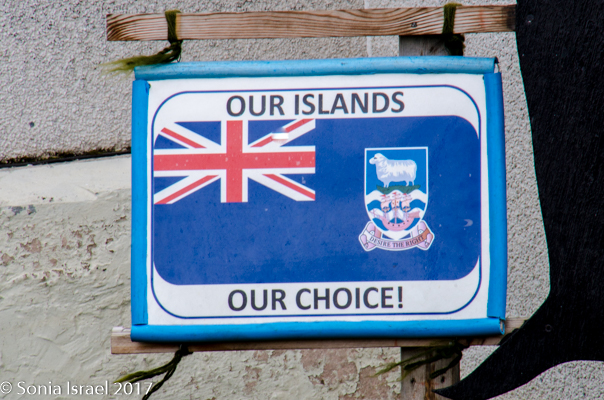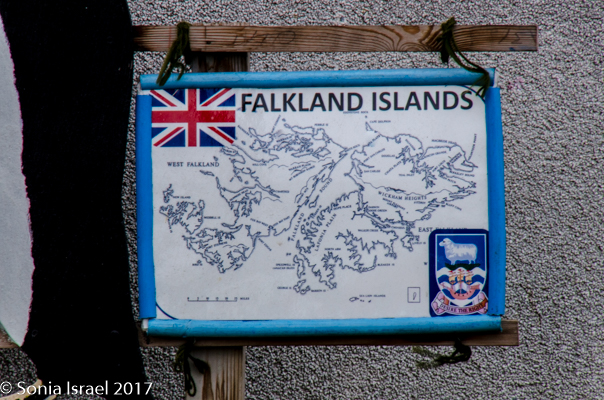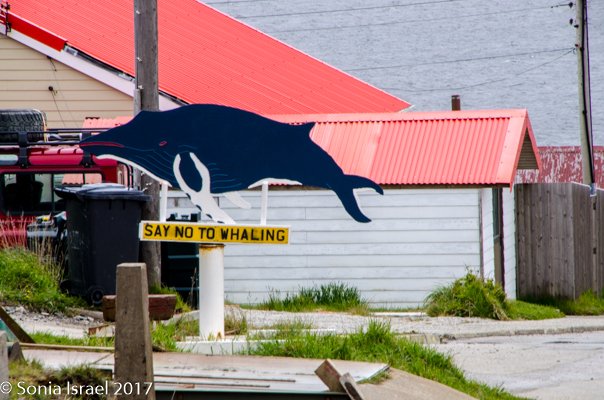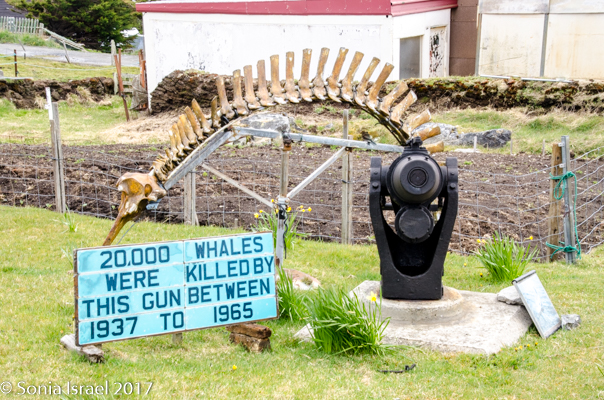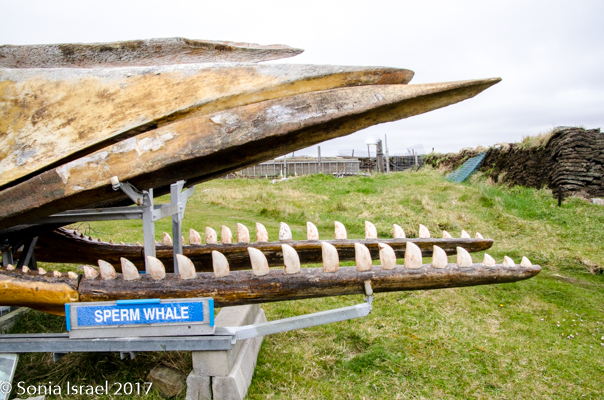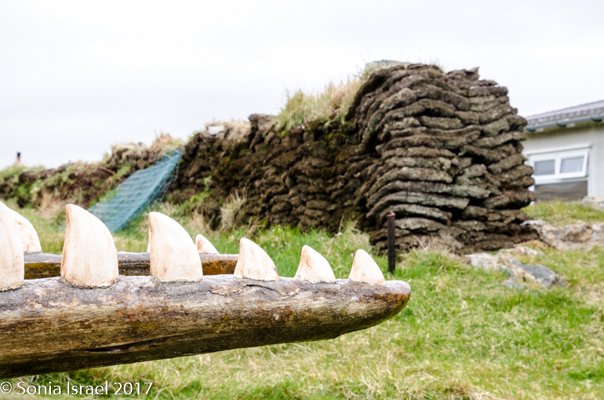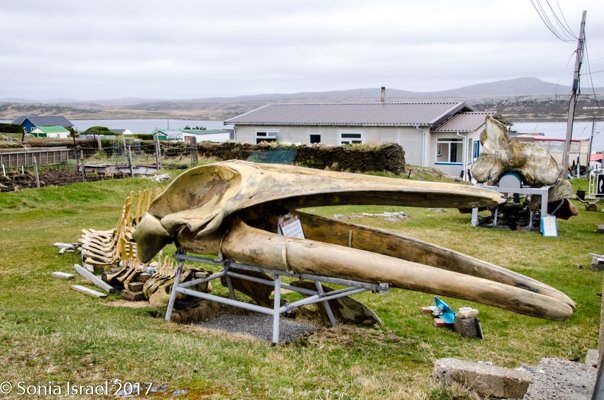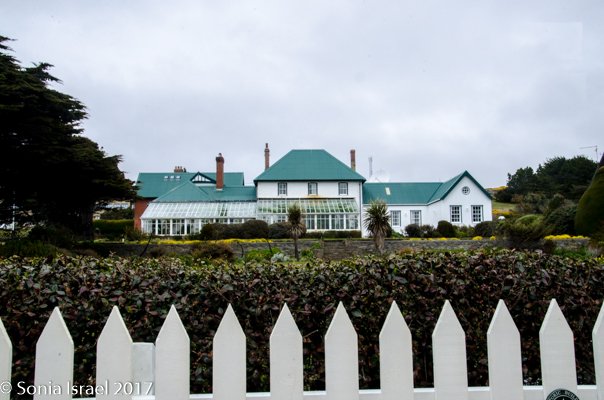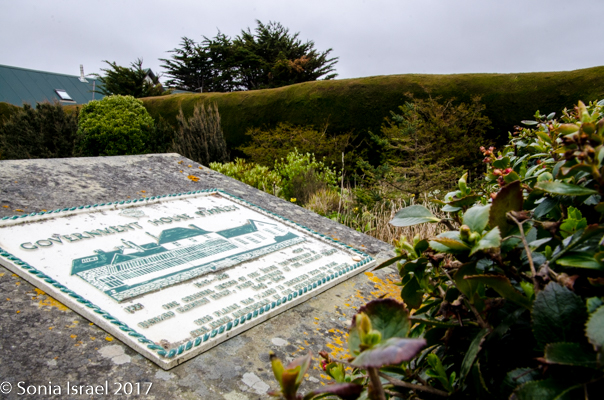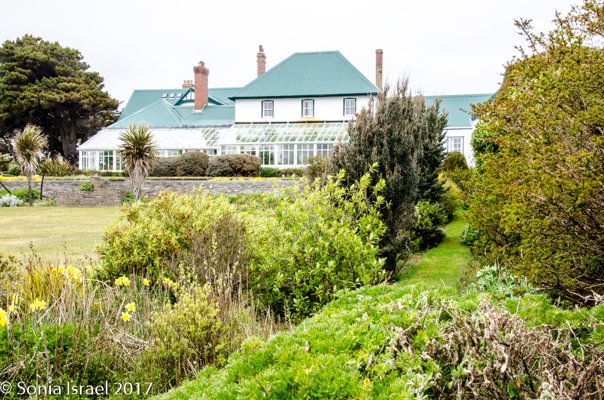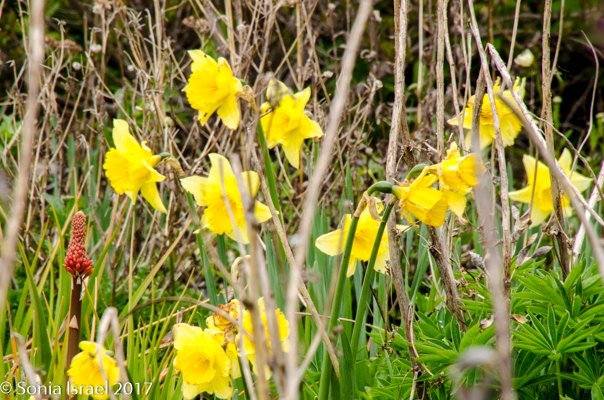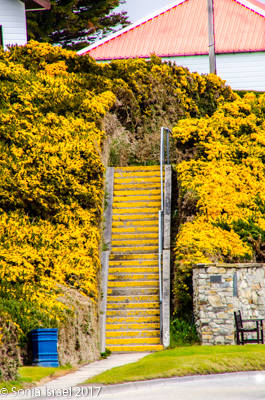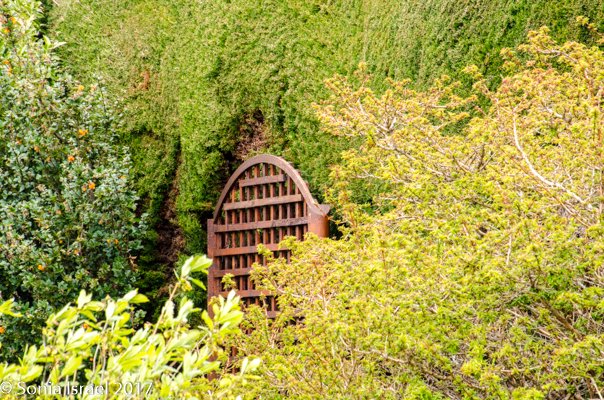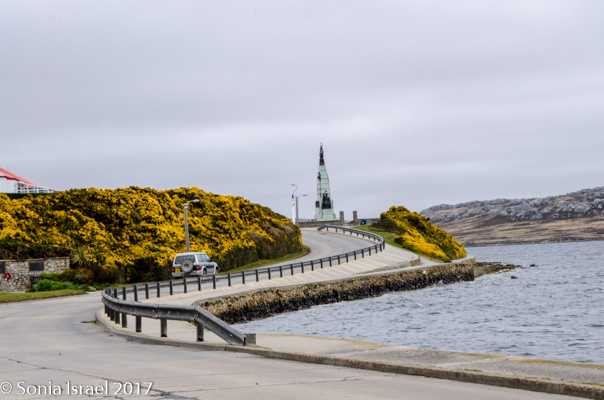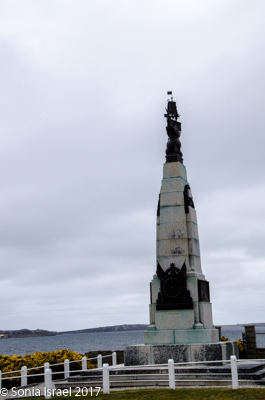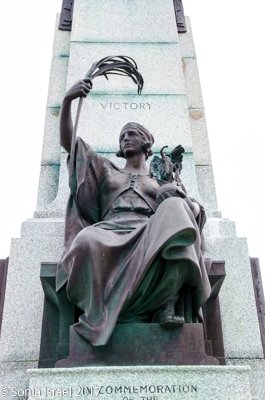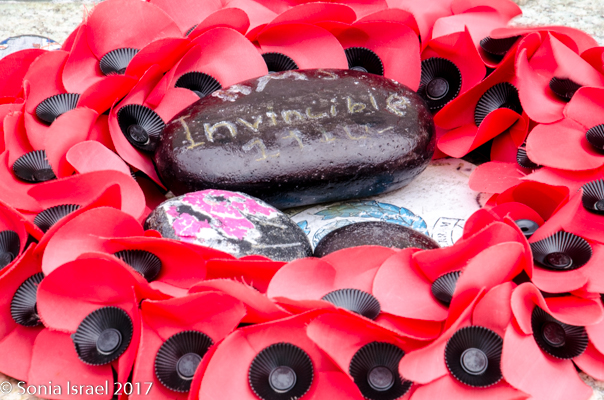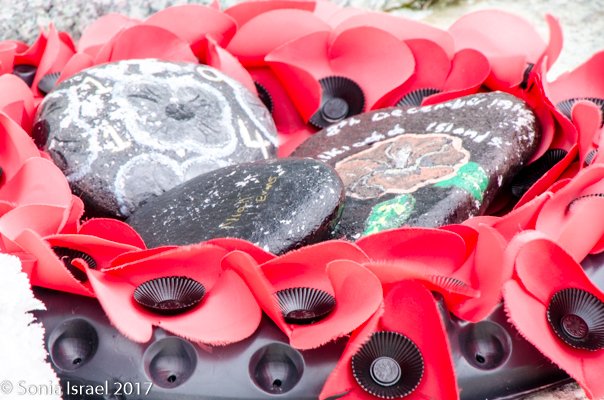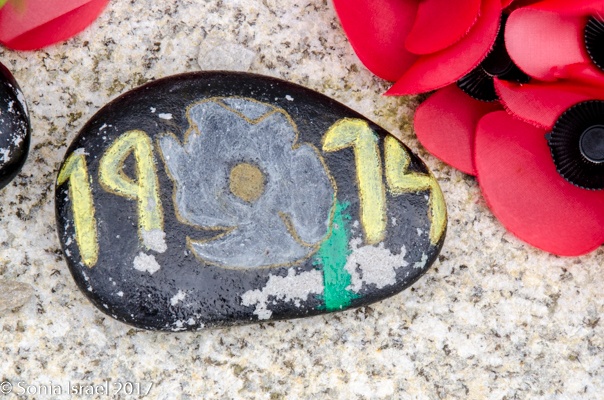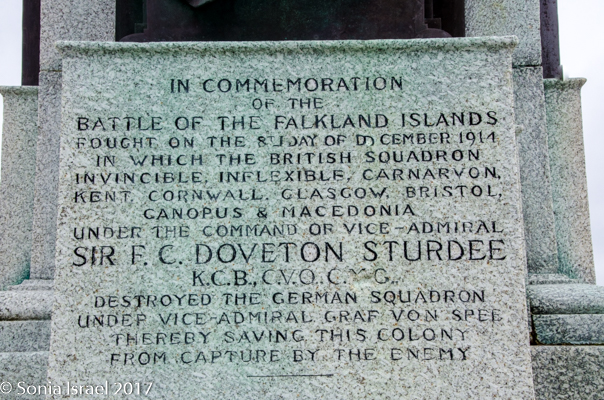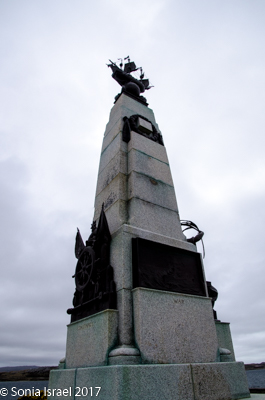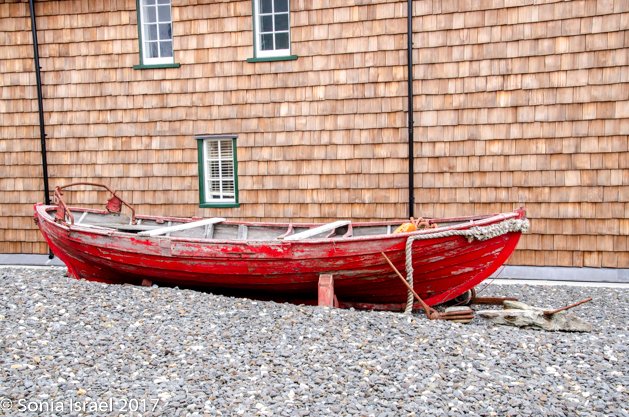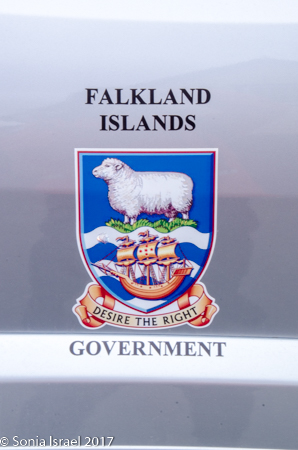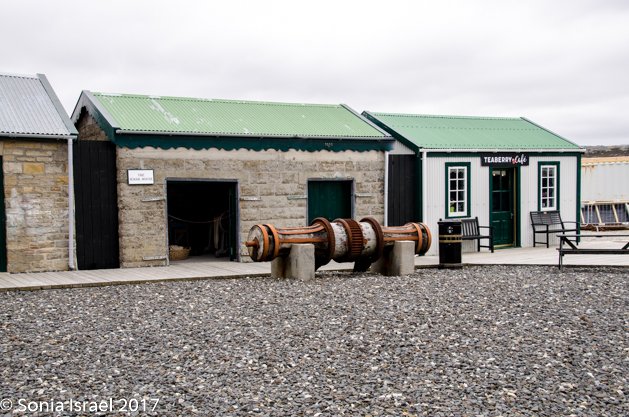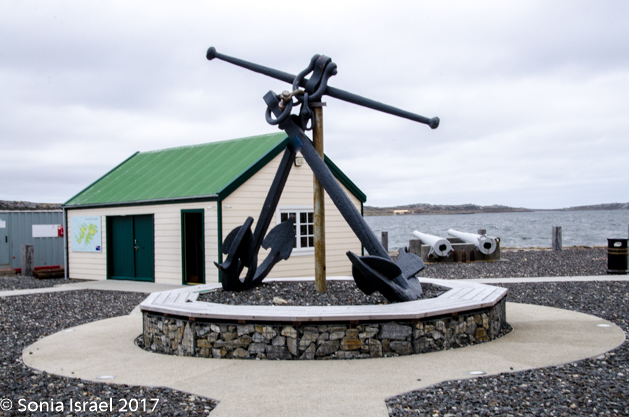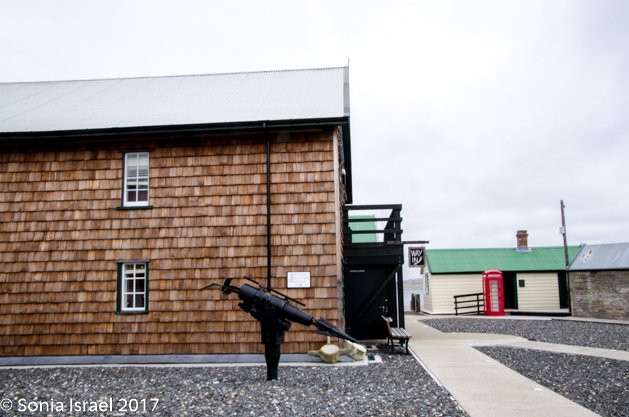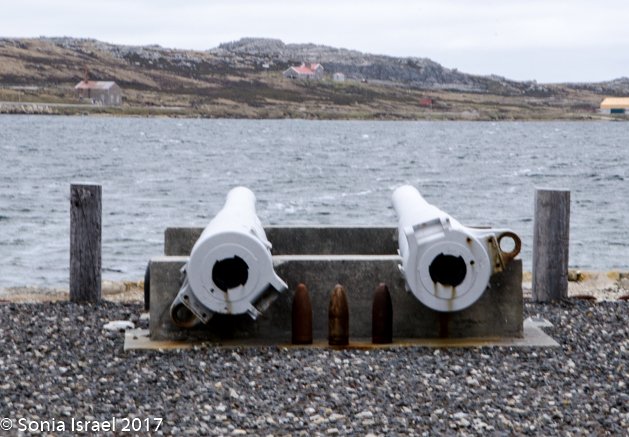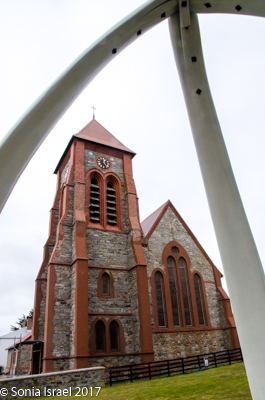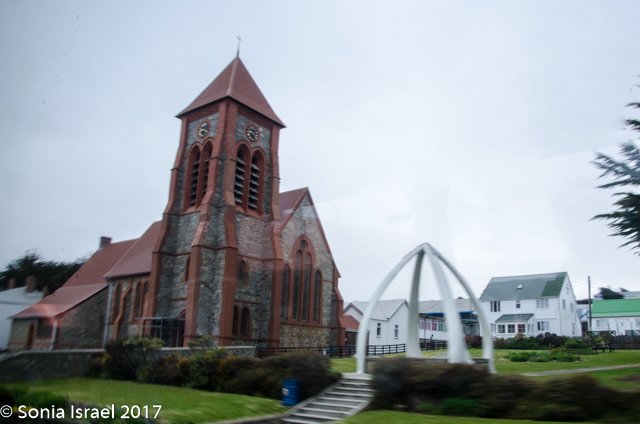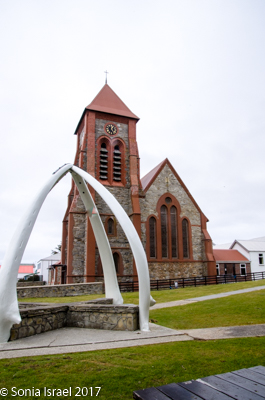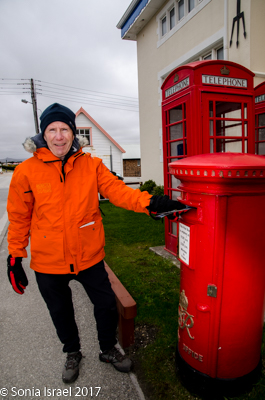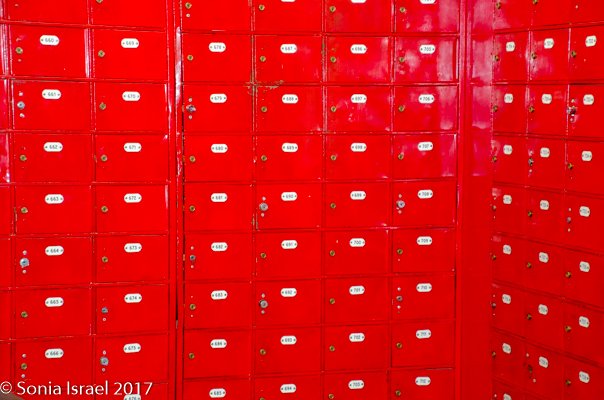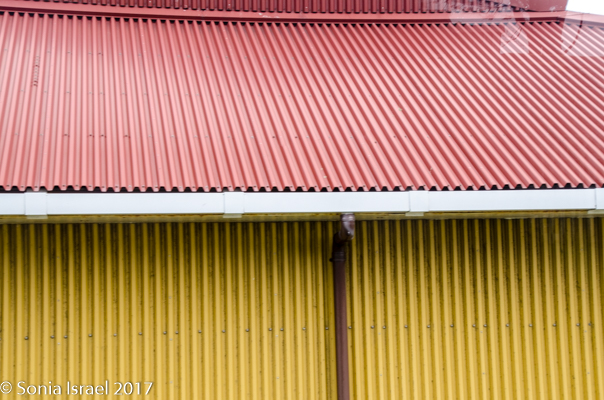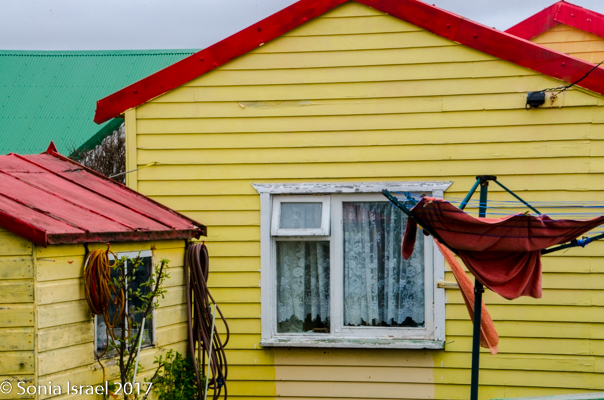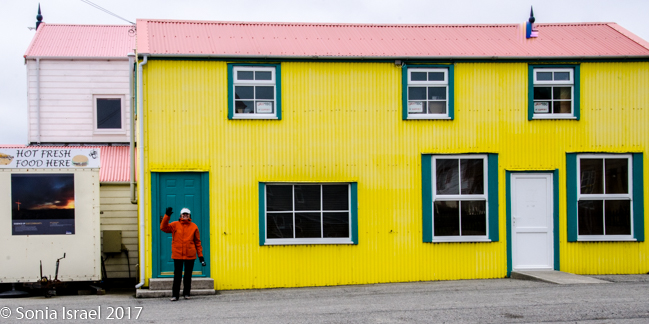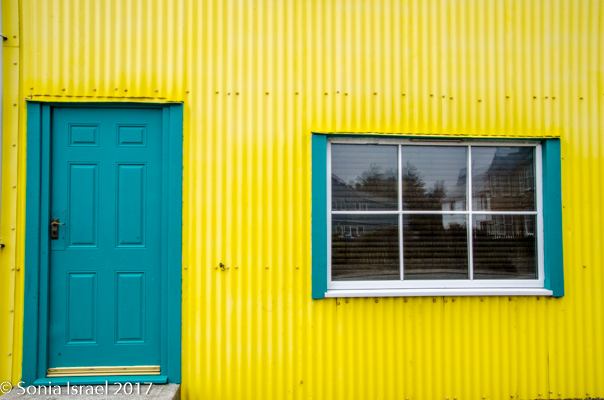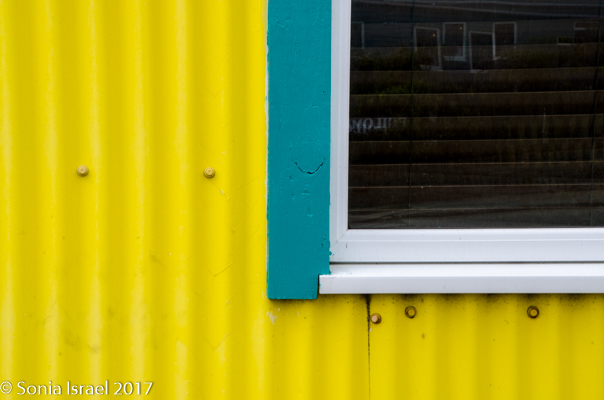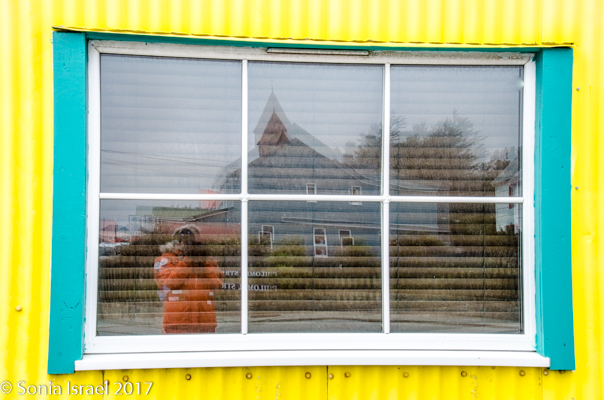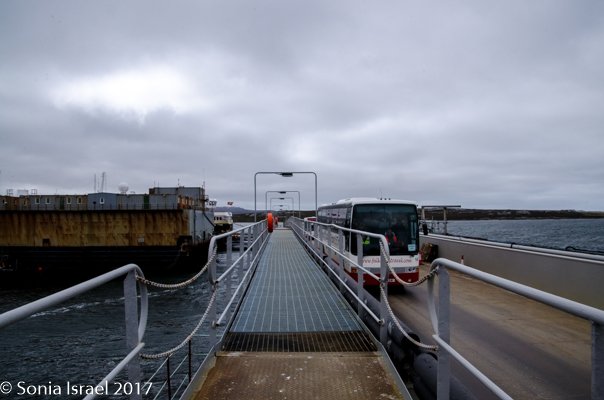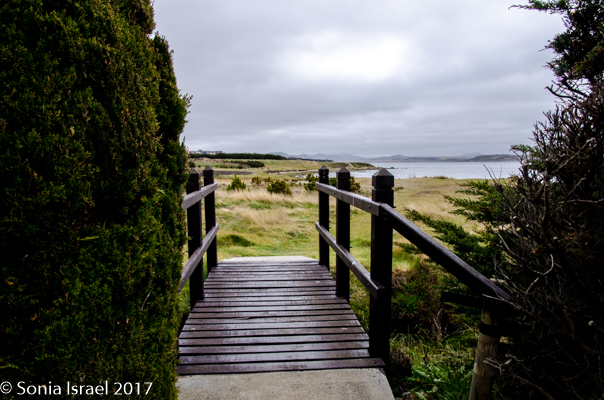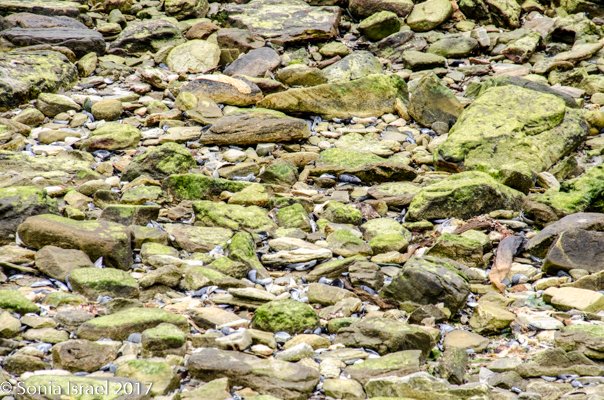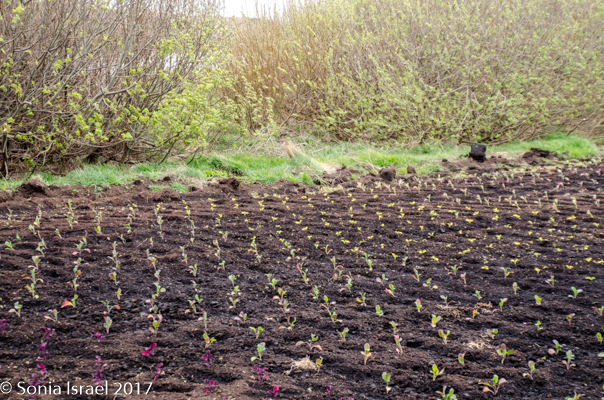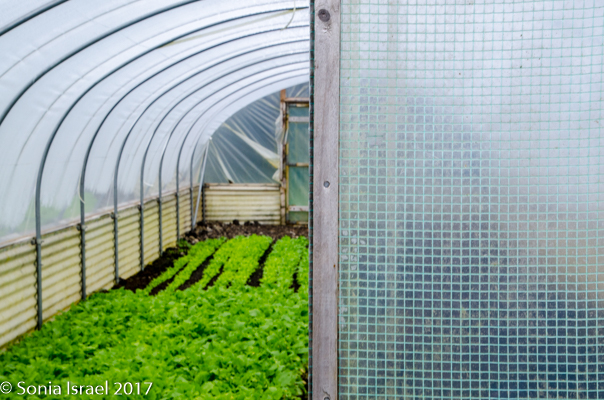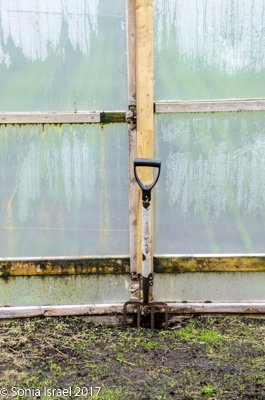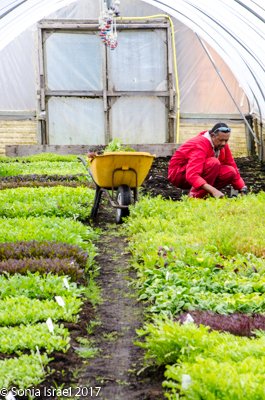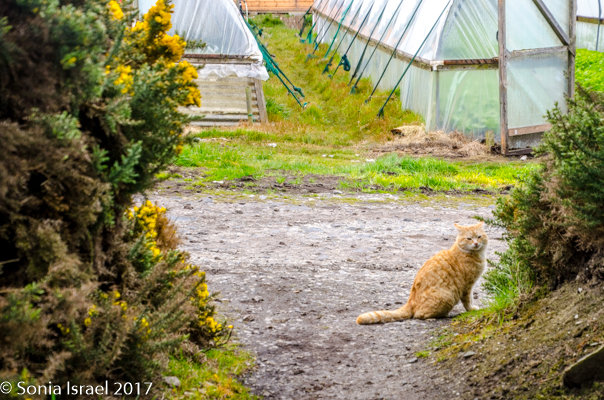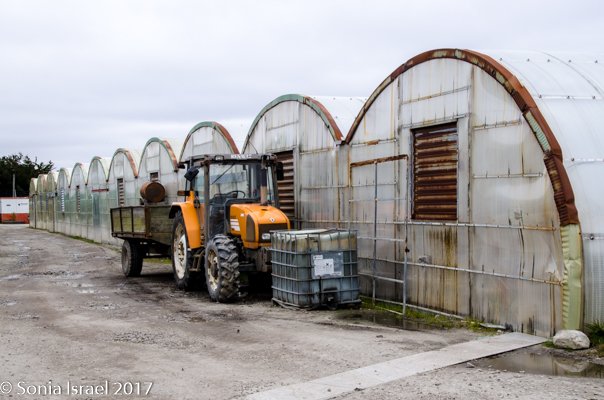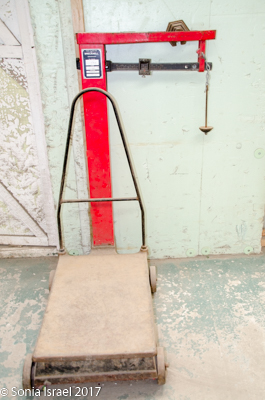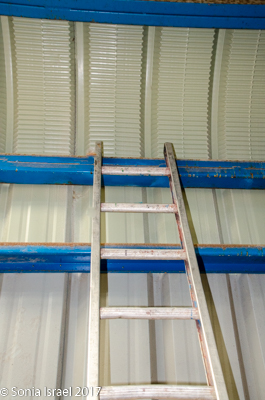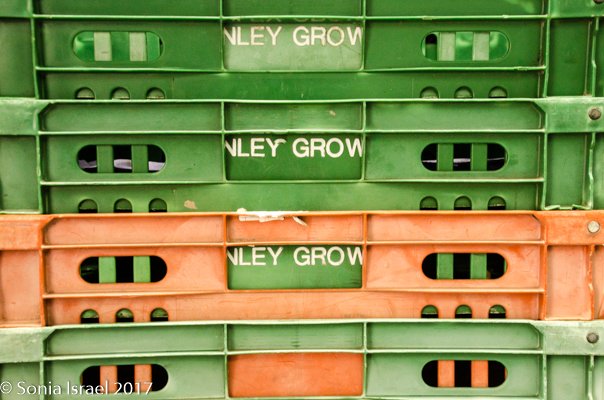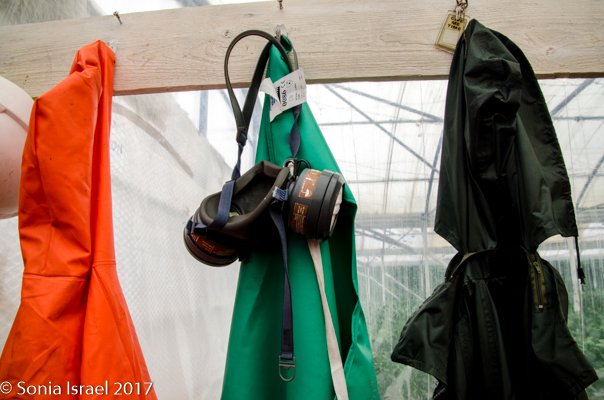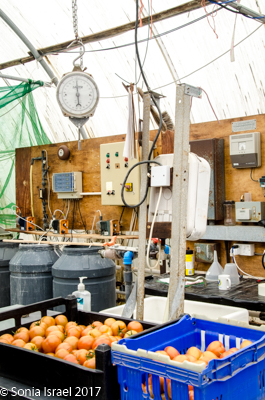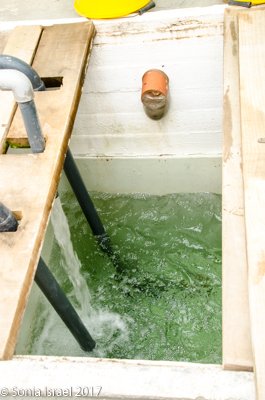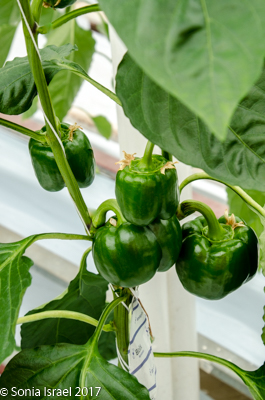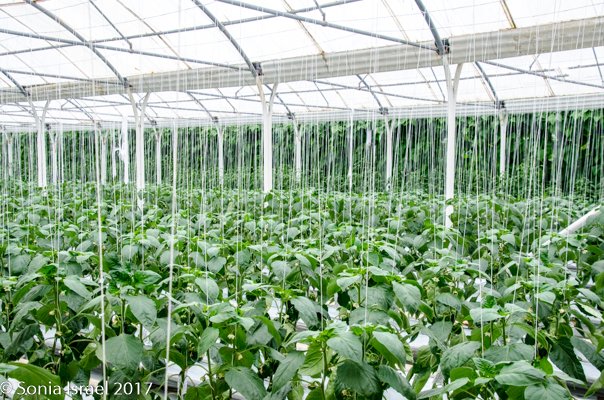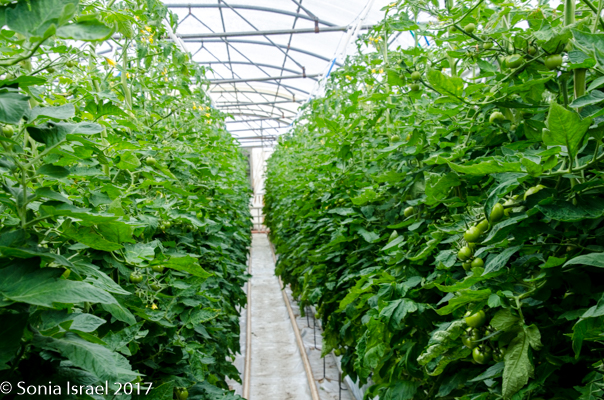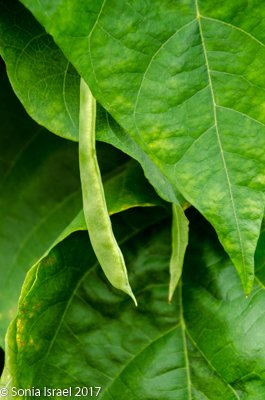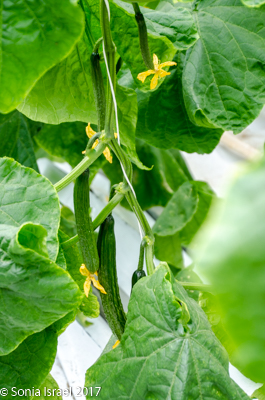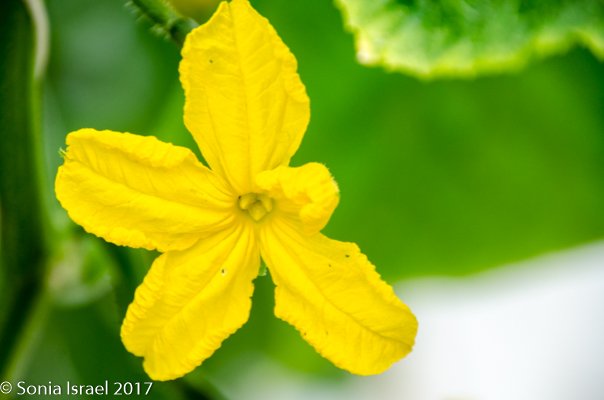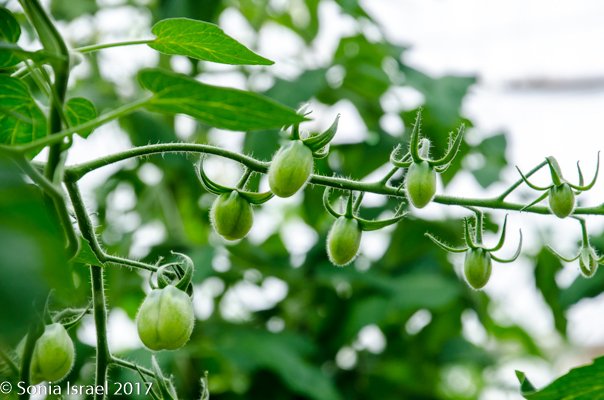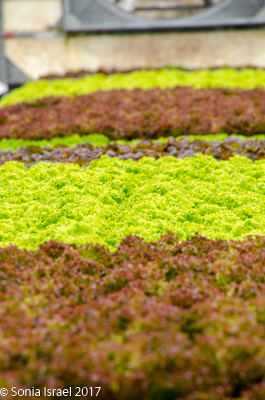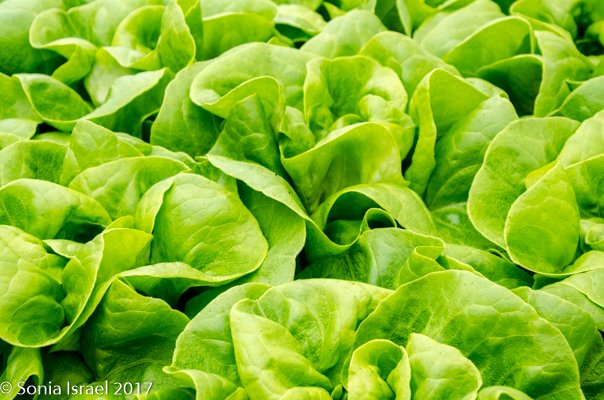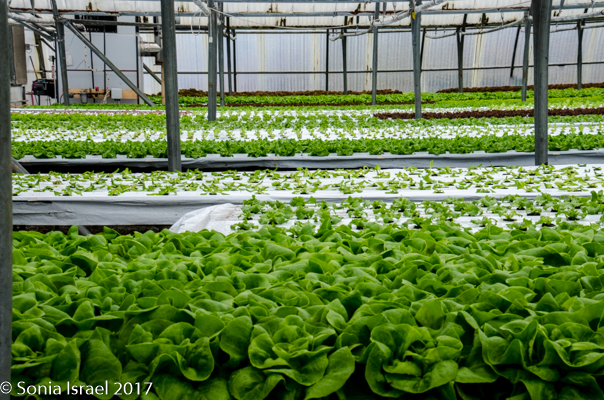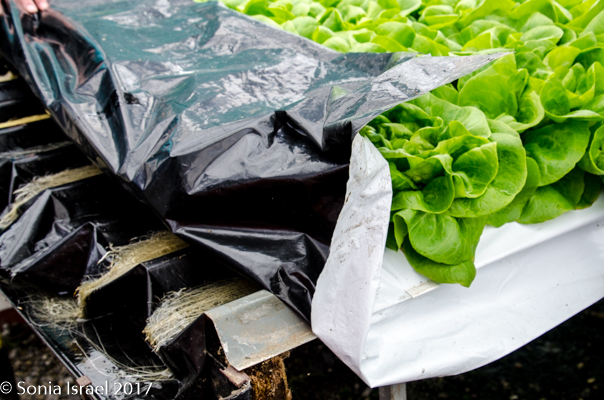Saturday Oct 28, 2017
The Falklands
This was our second day in the Falklands, this time on East Falklands. We docked at FIPASS – Falklands Interim Port and Storage System. Although it is called the “Interim” port, it has been there for twenty years. I opened my blinds and was staring right at the buildings on the dock. The shapes and the colors immediately struck me. And it was clear we were in a British colony as right outside my window were British telephone booths. And a workman walking as if he were the British Imperial guard, but with a hard hat instead of a bearskin (the tall fur cap). And of course, I could see all the houses with their colorful roofs.
This is a good time for a bit of background on the Falklands. The population of the Falklands is about 3000, with 2500 living in the capital, Stanley on the East Falklands. Most of the population are native born of British decent. The United Kingdom and Argentina both claim the Falkland Islands. The UK, and most of the locals, believe that they should have the right to self-determination. There were signs everywhere saying that they should get to decide their own fate. And in all the elections, 99.8% of the voters want to stay British. Argentina, on the other hand, posits that it acquired the Falklands from Spain when it achieved independence in 1816, and that the UK illegally occupied them in 1833. Because of this on-going dispute, the island has two names. The British call is the Falklands. Argentina calls it Malvinas. And the cities and smaller islands also all have two names.
Tour of Stanley
After breakfast embarked on a tour of the town. We boarded the bus and had a wonderful guide, whose name I don’t recall, but who was an elderly gentleman who lived here his whole life. With such a small population, everyone knows everyone and gossip is rampant. As we passed different individuals, he would name them and tell us a bit about them.
Stanley Background
Stanley is the capital of the Falkland Islands. And although it is a capital, it feels more like a frontier town. As mentioned previously, the Falklands are made up of over 750 islands, but the two main ones are East Falklands and West Falklands and Stanley is on the East. It was established in the early 1840’s as a port since the site has a sheltered harbor and an abundant supply of peat and fresh water nearby. As a port in what seemed like the middle of nowhere, Stanley was actually right on the path of those boats going from the Atlantic, around the Cape Horn, to the Pacific or visa versa. At least until the Panama Canal was built.
Today Stanley is the hub of the Falklands, as local industry is growing and those living in the countryside are moving to the city. In the last 25 years, the population of Stanley has doubled in size to 2500 (out of 3000 on all the Falkland Islands).
As a harbor, Stanley had lots of small wooden boats, the boats of the times, stopping by to refuel and restock or to repair their ships. Because of the ice bergs and rocks, many would capsize and sink. It is estimated that 120 ships were lost around the coast of the Falklands. There were quite a few still in the harbor and archeologists come to study them to see how they had been constructed. For example, in 1879, the Lady Elizabeth was traveling from Vancouver, around Cape Horn to Africa to deliver wood, but was damaged around Cape Horn. An individual in Stanley bought the condemned boat, cargo and all, for 3000 pounds and then sold the wood right from the ship. The Lady Elizabeth’s remains now sit in the harbor.
So how small is Stanley itself, the capital of the Falklands? There are no traffic lights. When one of the two supermarkets got automatic doors, it was a big event and everyone was so excited and came out to see them. There is a hospital with 29 beds and schools for the children. In the countryside and on the farms, many of the kids learn from the internet or via telephone with a teacher visiting once every two weeks. And for high school, those from the countryside live in dorms in Stanley. Education is free and each child is given a set amount of money to be used for a university anywhere in the world. About 80% of those that leave the island for college, end up returning. Which is why most of the inhabitants on the Falklands were born there. And just like in Great Britain, one drives on the left, there are red telephone boxes and mail boxes and the currency is the Falklands pound which is exactly the same as the British pound.
The original homes were built with a timber frame with corrugated iron roofs. One side was more slanted than the other and there was a sun porch. There had no insulation. Heat came from the fireplace which was heated with peat. There are plenty of peat bogs on the island, but it is such hard work that only a few families still cut the peat. Most now use kerosene or gas.
- Peat
- Peat
- Peat
The British then brought over house kits, with insulation, and the locals realized they didn’t have to be cold! Many of the Quonset huts have been turned into homes or garages.
The main industries today are sheep (for wool) and fishing. Originally there were no sheep on the Falklands, but Scottish shepherds and sheep were imported about 500 years ago and now there are 500,000 sheep on the Islands. But the land was vast to it was hard to herd to the sheep. They needed to use horses. The Scottish knew nothing about horses, so Argentinian gauchos were brought in to teach them. The Scots needed to learn Spanish, and till this day, Spanish words are used when talking about the land and the sheep. So what you have is Scottish gauchos!
But the biggest industry is fishing. Fishing began in earnest in 1987 and now the economy is based on fishing. The income from the fishing industry was about 4.5 million pounds in 1987. Then they smartened up and started selling fishing licenses to the Poles and the Russians and everyone else. Now the income from fishing is 28 million pounds.
Because of this, the Falklands are financially independent of Britain. They have no debt. They take no aid. The GDP per person is the fifth highest in the world. So what do they need from Britain? Two things. The first is defense. Although there is a local defense force, most of the defense of the islands comes from Great Britain.
The second is to have someone to speak for them to those that don’t believe they exist, i.e., Argentina.
The Lady Elizabeth and the Pale Maiden
We stopped at one point, at the foot of a bridge at Whalebone Cove, to view the Lady Elizabeth and our ship in the distance. There were a group of locals there with their canoes. It looked like they were having some kind of drill. I watched them while my fellow passengers wandered about. Whereever we go, we look like a gaggle of orange geese.
And when I finally started walking around, I found the Pale Maiden, a native  species and the national flower of the Falklands. This elegant flower is bell-shaped with white petals with distinctive violet stripes.
species and the national flower of the Falklands. This elegant flower is bell-shaped with white petals with distinctive violet stripes.
Diddle dee and diddle dum, or at least diddle dee
We passed fields of low bushes, the diddle dee plant whose very red berries make a great jam, or so we were told. But if you eat it, you have to return to the Falklands. Such goes the legend.
There is another low growing bush here called the Teaberry. In the spring, families come to pick the berries, but just like the children’s book, Blueberries for Sal, the little kids put more of the berries in their tummies than in their pails.
We passed Beach Bay, a small, lovely sandy beach which is the only one where the locals could swim, as it was the only one that was not full of mines placed by the Argentines during the Falklands War.
Falkland War
This is a good point to talk about the Falkland War, also called the Falklands Conflict, from the perspective of those living on the Falklands. The conflict happened in 1982, from April 2 to June 14. 74 days. The local Brits woke up one morning to find Argentinian soldiers in their yards. Things were not going well in Argentina and the government thought it could divert the negative sentiment by starting a war. It was all about nationalism. In the end, Argentina lost, but it doesn’t think so. The conflict lasted 74 days and ended with the Argentine surrender on 14 June 1982, returning the islands to British control. In total, 649 Argentine military personnel, 255 British military personnel, and three Falkland Islanders died during the hostilities.
As mentioned before, the conflict was a major episode in the continuing confrontation of who “owns” the islands. Argentina asserted (and maintains) that the islands are Argentine territory, and the Argentine government thus characterized its military action as the reclamation of its own territory. The British government, on the other hand, regarded the action as an invasion of a territory that had been a Crown colony since 1841. The Falkland locals, who have inhabited the islands since the early 19th century, are predominantly descendants of British settlers, and thus prefer British sovereignty. While neither officially declared war, both governments declared the Islands a war zone.
And although it is called the Falklands Conflict, it took place on South Georgia as well.
Mines
One remnant of the conflict was the mines that were left in the fields. Several people were injured soon after the end of the conflict, when they accidently stepped on a mine. So the Falkland locals decided to place two rows of fences around the mine fields to keep people out. They figured they had so few people and plenty of land, so there was no reason to try to clear the mines. Just keep people away. But then in 1996, Great Britain signed the Ottawa Accord which was an agreement, in part, to clear all mines in the world. The Falklands felt it was a waste of money as they didn’t need the land and it was more important to spend that money clearing mines in Laos and Cambodia. But Great Britain insisted. So experienced mine clearers were brought in from Zimbabwe. They worked on their hands and knees, slowly and carefully removing the mines. And in all fairness, those Argentinians living on the Falklands supplied them with the mine maps. Some mines are still being removed. And many of the Zimbabwe’s ended up staying on the Falklands.
The Stanley Totem Pole
As we drove around the island, we passed a totem pole. Yes, a totem pole. When the British airmen were here for years, they became homesick, either for home or for their pubs. So they started building a totem pole.
Situated on the Stanley by-pass road, east of the town, the Totem Pole is a quirky structure of signposts listing the distances to various places in the world. Although originally created by the military personnel, signs have been added by many visitors. Most are villages, towns and cities in the UK at roughly 8,000 miles away but locations in the American continent can also be found, along with Europe and even Russia.
Stone Runs
Along the road we saw the Falklands stone rivers or stone runs. These are literally rivers of rocks which were formed by boulders being moved down the mountains by the cold weather and the glaciers. The result is a landscape that looks striped with alternating green grass and gray stones. It was quite eerie looking. We passed sheep farms. Windmills used for wind power.
Mike Butcher and the Whales
We finally made it back into “downtown” and stopped at one of the local homes, that of Mike Butcher. Mike is a big proponent of anti-whaling, and each time a whale is beached on the island, the bones end up in his yard. He has quite the collection! He is also an ardent “Keep Falklands British” proponent.
Government House
Our next stop was the Government House which is the home and gardens and offices of the British appointed Governor of the Falklands. It has been described as a grey, stone-built and slated, calling to mind a mansion in Shetland or Orkney. In other words, it doesn’t really fit in in the Falklands. Sir Ernest Shackleton stayed here during his famous expedition. He described his time here as being “far colder than any time on the ice.” The commentary continues saying that it is unclear if that referred to the welcome he received or to the temperature!
1914 Battle of the Falklands Memorial
Just past the Government House, is an obelisk commemorating a WWI naval engagement. On December 8, 1914, nine British ships, refueling in Stanley, quickly responded to the sighting of five German cruisers that had surprised them earlier in southern Chile. The British sank four of the cruisers in the battle, in which 1871 Germans lost their lives. Just 10 British seamen were killed. The four sides of the monument are dedicated to peace and victory. A figure of Victory faces east, looking out to sea towards the site of the battle. She holds a palm branch in one hand and an orb in the other. At the base of the monument were hand made wreaths in memory of that war. It is believed to be the world’s most southerly memorial to the Great War.
Historic Dockyard Museum
The tour ended at the Historic Dockyard Museum, part of the Falkland Islands Museum and National Trust, which was quite interesting. The mission of the museum is to promote awareness and appreciation of the history and heritage of the Falkland Islands, and to protect and preserve this history for future generations. In short, it celebrates the cultural heritage of the Falklands. The galleries include the social history, maritime history, the Falklands War and the Antarctica heritage. Here’s a little-known fact I learned there. Charles Darwin spent more time on the Falklands than he did on the Galapagos. His world-changing theories were stirred by a wolf-like beast, the Warrah, that once roamed the Falklands, and only the Falklands. The Warrah is now extinct but was the only land mammal on an island populated by birds and sea life. Almost nothing is known about the Warrah or how it got to the Falklands. But for me the most interesting part of the museum was the short film about the Falklands Conflict told from the perspective of those that were children at the time. The trauma of having Argentinian soldiers march down your street, in your garden and in your home, the bombs falling, all were very traumatic, as you would expect. But hearing it from them made it all very real.
Christ Church Cathedral
After the museum, Andy and I walked along the streets of Stanley, stopping in gift shops and taking pictures. We passed the Christ Church Cathedral, the southernmost Anglican cathedral in the world. In front of the church is a whalebone arch, made from the jaws of two blue whales, which was built in 1933 to commemorate the 100-year anniversary of British rule. An image of the church is on the Falklands banknote. We didn’t get to go inside, but just enjoyed the sight of these huge whale bones and the different views from different angles.
Stanley Post Office
We were given two postcards of the Falklands, with stamps on them, so we made our way to the post office to mail them. The post office has two rooms, one filled with red mailboxes and Philatelic Bureau, selling first issue stamps (which most tourists stop to by) and everyday stamps. The mailbox outside was an old red one which looked quite British, and it stood next to a British phone booth. Since the advent of the cell phone, there are not many places in the world one still sees a phone booth.
FIRS or FIBS
The city is very quaint. There is the office of the weekly Penguin News newspaper.  There is the Falkland Islands Radio Station (FIRS), originally called the Falkland Islands Broadcasting Station (FIBS). Now you see why they changed the name.
There is the Falkland Islands Radio Station (FIRS), originally called the Falkland Islands Broadcasting Station (FIBS). Now you see why they changed the name.
Wind, wind, wind
Stanley, and the Falklands in general are very windy with a westerly wind, and that 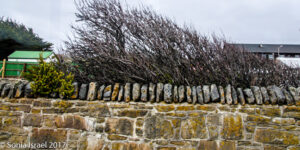 direction never changes. The trees are therefore all bent over. The locals joke that you can always tell someone from the Falklands as they walk tilted over. And we were feeling that wind, so we headed to the tourist office where we could grab the shuttle back to the boat. Right next door was a bright yellow building with a pink roof and green window trim, which reminded me of another yellow and red home we had seen earlier in the day. One thing about Stanley, it is colorful!
direction never changes. The trees are therefore all bent over. The locals joke that you can always tell someone from the Falklands as they walk tilted over. And we were feeling that wind, so we headed to the tourist office where we could grab the shuttle back to the boat. Right next door was a bright yellow building with a pink roof and green window trim, which reminded me of another yellow and red home we had seen earlier in the day. One thing about Stanley, it is colorful!
Stanley Growers Hydroponics Farm
In the afternoon, we had one more tour to take, to the Stanley Growers Hydroponics farm. A handful of us bundled up and walked across the bridge from the ship to the farm which was right by the port. But there was no one to be found. Eventually Tim Miller, the owner, appeared, apologizing for being late. He began by telling us there was some bad news and we thought we couldn’t see the farm. But no, the bad news was that his wife was under the weather and so there would be no tea and cookies.
Tim walked us around the greenhouses where potatoes and strawberries and other vegetables and flowers were growing in soil. But the more interesting part was the hydroponics. Hydroponics is method of growing plants without soil, using nutrient solutions in water. The plants may be grown with only their roots exposed to the water solution, or the roots may be supported by gravel or something like that.
We walked in and two things hit us. The heat. And the wonderful smell of peppers. There were rows and rows of bell pepper plants, with strings reaching to the ceiling, looking like lots of harps, or works of art.
There were also rows of beans, eggplants, cucumbers and lots and lots of tomatoes. And a whole room of lettuce in all different colors. It was like carpets of curvy, velvety, lettuce.
Tim supplies the entire Falkland Islands, as well as any ships that stop by (like us) 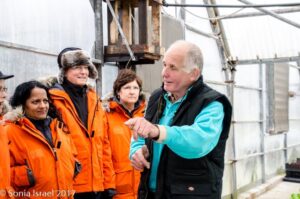 and once in a while, the research stations on Antarctica. He came from a Falklands family of sheep farmers, but realized his passion was horticulture. When the government decided that they needed to grow their own vegetables, they brought over a horticulturist who taught them. So Tim apprenticed for 3 years and now, 30 years later, he IS Stanley Growers.
and once in a while, the research stations on Antarctica. He came from a Falklands family of sheep farmers, but realized his passion was horticulture. When the government decided that they needed to grow their own vegetables, they brought over a horticulturist who taught them. So Tim apprenticed for 3 years and now, 30 years later, he IS Stanley Growers.
And then it was time to leave the Falklands. We would come back here on our last day before flying home. But for now, we knew things were about to change.

